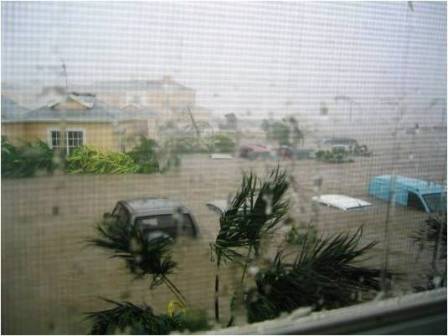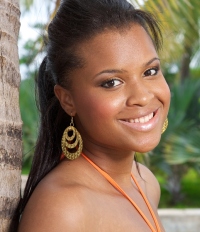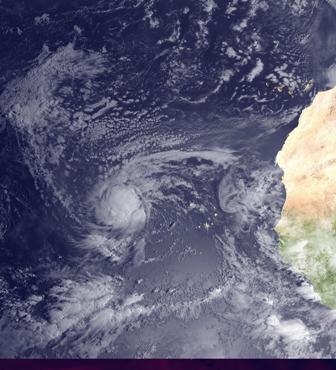Archive for September, 2010

Cayman marks sixth anniversary of Hurricane Ivan
 (HMCI): As Igor rumbles across the Atlantic from its birth place south of the Cape Verde Islands, Cayman is also remembering another storm that came from the same place. It is six years this weekend since the infamous Hurricane Ivan hit these shores and it remains one of the most powerful hurricanes to hit the Caribbean in recorded history. On September 2 Ivan developed into a tropical depression, it became a tropical storm on the following day and reached hurricane status on 5 September. Eventually it made its way to the Cayman Islands when on Sunday 12 September the eye passed 21 miles South West of Grand Cayman with winds of 150 mph and gusts of 220 mph.
(HMCI): As Igor rumbles across the Atlantic from its birth place south of the Cape Verde Islands, Cayman is also remembering another storm that came from the same place. It is six years this weekend since the infamous Hurricane Ivan hit these shores and it remains one of the most powerful hurricanes to hit the Caribbean in recorded history. On September 2 Ivan developed into a tropical depression, it became a tropical storm on the following day and reached hurricane status on 5 September. Eventually it made its way to the Cayman Islands when on Sunday 12 September the eye passed 21 miles South West of Grand Cayman with winds of 150 mph and gusts of 220 mph.

 The total economic impact to the Cayman Islands was estimated by the United Nations ECLAC team to be 3.4 billion (183 % of GDP). Approximately 83% or 13,535 units of the total housing stock in the Grand Cayman suffered some degree of damage. Dwellings which were situated on the sea shore, in low lying, or swampyareas suffered the most severe damage. Older and less well constructed housing was also severely affected.
The total economic impact to the Cayman Islands was estimated by the United Nations ECLAC team to be 3.4 billion (183 % of GDP). Approximately 83% or 13,535 units of the total housing stock in the Grand Cayman suffered some degree of damage. Dwellings which were situated on the sea shore, in low lying, or swampyareas suffered the most severe damage. Older and less well constructed housing was also severely affected.
University offers opportunity to appreciate local dance
 (CNS): The University College of the Cayman Islands (UCCI) is offering a new course on Caribbean and local dance forms exploring the role of traditional Caribbean its meaning, purpose and relationship to other art forms in contemporary Caymanian society. The course is an intentional departure from the traditional academic norm at UCCI as UCCI President Roy Bodden said arts have much to offer in terms of personal growth and development. Facilitated by Adjunct Professor Dr. Monika Lawrence, from the University of Technology in Jamaica, as well as physically experiencing selected dance styles, students can study dance theory and evaluate Caribbean dance history within the context of cultural identity and development.
(CNS): The University College of the Cayman Islands (UCCI) is offering a new course on Caribbean and local dance forms exploring the role of traditional Caribbean its meaning, purpose and relationship to other art forms in contemporary Caymanian society. The course is an intentional departure from the traditional academic norm at UCCI as UCCI President Roy Bodden said arts have much to offer in terms of personal growth and development. Facilitated by Adjunct Professor Dr. Monika Lawrence, from the University of Technology in Jamaica, as well as physically experiencing selected dance styles, students can study dance theory and evaluate Caribbean dance history within the context of cultural identity and development.

Minister calls on community to tackle diseases
 (CNS): On Caribbean Wellness Day the health minister has said that despite medical advantages in our region, it faces the highest rates of chronic disease in the Americas. Mark Scotland said that while we have more knowledge and better testing, chronic illness figures are increasing, especially in childhood obesity and diabetes. He noted, however that these conditions are preventable if people make conscious decisions to live better. He called on parents to make better choices about health and lead by example with how they spent leisure time and the decisions they made in the grocery store.
(CNS): On Caribbean Wellness Day the health minister has said that despite medical advantages in our region, it faces the highest rates of chronic disease in the Americas. Mark Scotland said that while we have more knowledge and better testing, chronic illness figures are increasing, especially in childhood obesity and diabetes. He noted, however that these conditions are preventable if people make conscious decisions to live better. He called on parents to make better choices about health and lead by example with how they spent leisure time and the decisions they made in the grocery store.
Mark Scotland’s message:
Caribbean Wellness Day was first celebrated three years ago to promote healthy living and encourage people to develop good health practices. With the theme ‘love that body’, this day places emphasis on national and community level activities that aim to improve the people’s health.
And so, as we celebrate this year’s Caribbean Wellness Day, it is fitting – and imperative – that we pay attention to the pending health crisis that faces our region. Ailments such as hypertension, ischemic heart disease and stroke, cancer, chronic respiratory diseases and diabetes are the leading causes of premature death in this part of the world. A staggering two of three deaths occurring in persons younger than 70 years results from a chronic disease.
Ironically, even as this region has made great strides in securing better medical care for its citizens, we still find ourselves facing the highest rates of chronic disease in the Americas. We have more knowledge and better testing, but we are still witnessing rapidly increasing chronic illness figures, especially in childhood obesity and diabetes.
Apart from negatively affecting the quality of life of sufferers and their families, chronic diseases impose a huge financial burden on individuals and governments alike. Indeed, according to a CARICOM estimate, the societal costs of diabetes alone in Latin America and the Caribbean amounted to some $53 billion in 2000.
But there is good news: While it is escalating, this chronic disease epidemic is in large part preventable, particularly if we all make conscious decisions to live better.
In this regard, we are fortunate here in Cayman to see a growing partnership between the private and public sector in securing the long-term health of our population. For instance the free health screenings (for diabetes, hypertension and cholesterol) on offer this month, compliments of the Heart Health Centre and the Cayman Islands Health Services Authority.
The Public Health Department will also continue this month with its health awareness campaign, presenting school children with fruit and water at school.
Of course governments should provide good healthcare and support, but the sobering truth is that we are the only ones who can thwart this potentially crippling health emergency. Truly then, the difference does start at home. It begins with the example we set as parents and it flows from the simple choices we make in the supermarket and in pursuing our recreational activities.
My hope therefore is that this Caribbean Wellness Day will inspire you to ‘love that body’ and make at least one positive change in your life. Without question, living healthily is one of the best investments you can possibly make for you and your family. So why wait?

Love that body
The observance of Caribbean Wellness Day (CWD) has been one of the commitments made by the Caribbean Community (CARICOM) heads of government in the fight against chronic diseases. Initiated in 2008, this is a collective regional recognition of the physical, economic and social burdens caused by lifestyle-related diseases such as diabetes, hypertension, stroke, heart disease, obesity and some types of cancer.
The corresponding theme “Love that Body” aims to heighten awareness of health and well being, encourage persons to engage in regular physical activity and choose healthy lifestyles.

Love that body
The observance of Caribbean Wellness Day (CWD) has been one of the commitments made by the Caribbean Community (CARICOM) heads of government in the fight against chronic diseases. Initiated in 2008, this is a collective regional recognition of the physical, economic and social burdens caused by lifestyle-related diseases such as diabetes, hypertension, stroke, heart disease, obesity and some types of cancer.
The corresponding theme “Love that Body” aims to heighten awareness of health and well being, encourage persons to engage in regular physical activity and choose healthy lifestyles.

Love that body
The observance of Caribbean Wellness Day (CWD) has been one of the commitments made by the Caribbean Community (CARICOM) heads of government in the fight against chronic diseases. Initiated in 2008, this is a collective regional recognition of the physical, economic and social burdens caused by lifestyle-related diseases such as diabetes, hypertension, stroke, heart disease, obesity and some types of cancer.
The corresponding theme “Love that Body” aims to heighten awareness of health and well being, encourage persons to engage in regular physical activity and choose healthy lifestyles.

Miss Caymans on tour as competition draws near
 (CNS): With only two weeks to go before the big night, the Miss Cayman Islands contestants have been getting out and about recently. The girls were visiting various tourist attractions and posing for photos on Grand Cayman with Sir Turtle this week and this weekend they head to the Sister Islands. Venessa Ebanks, Mysti Bush, Trudy Ann Duncan, Shari Walton and Cristin Alexander will spend the weekend touring Cayman Brac and Little Cayman as well as saying hello to residents and supporters.
(CNS): With only two weeks to go before the big night, the Miss Cayman Islands contestants have been getting out and about recently. The girls were visiting various tourist attractions and posing for photos on Grand Cayman with Sir Turtle this week and this weekend they head to the Sister Islands. Venessa Ebanks, Mysti Bush, Trudy Ann Duncan, Shari Walton and Cristin Alexander will spend the weekend touring Cayman Brac and Little Cayman as well as saying hello to residents and supporters.
 Contestant # 1: Venessa Ebanks
Contestant # 1: Venessa EbanksA self described tomboy as a child, Venessa grew to be a major sport enthusiast who actively participated in many extra-curricular events and sports competitions in high school. Today, this West Bay resident has evolved into a well-rounded young woman who is confident that the Miss Cayman Islands pageant will help her lose her shyness and equip her to face any obstacles in life without hesitation.
Miss Ebanks hopes to become a successful photographer, film director or actress who will be a great ambassador for Cayman, similar to Selita Ebanks who has brought positive attention to the country and gained many accolades for her achievements in the fashion and entertainment industries. No stranger to community involvement, Venessa learned about goodwill and survival as part of Pathfinders when she was younger and was also a committed member of her church‟s mass choir. She has selected Lighthouse School as her platform and wholly enjoys music in all forms.
 Contestant # 2: Mysti Bush
Contestant # 2: Mysti Bush
Mysti resides in the district of Bodden Town and considers herself to be a mirror of her mother, a strong- minded, determined woman. What Mysti likes most about her country is the Caymanian culture and local cuisine. Among her favourites are run down and fried fish and fritters. To date, her greatest accomplishment is completing her Bachelors Degree in Finance at the University of Webber International. Here goals and aspirations include the attainment of a Masters Degree in Human Resources and to one day open her own Spa, specialising in massage therapy.
She states that the Miss Cayman Pageant would enable her to focus on more of her attention on concerns facing the Islands, such as the development of our youth and their education. She would like to bring more attention to Cayman‟s youth by offering more guidance and support, as she strongly feels they need more nurturing and someone to look up to. This is one of the reasons she mentors "Littles‟ in the Big Brother Big Sister Programme.
 Contestant # 3: Trudyann Duncan
Contestant # 3: Trudyann Duncan
Trudyann Duncan hails from the district of North Side where she‟s lived since she moved to Grand Cayman from Kingston, Jamaica. She aspires to be the best she can be at whatever she sets out to accomplish and entered this year‟s pageant for a chance to make a difference in other people‟s lives while working with her chosen charity. She also looks forward to enhancing her own growth and development via the training she has already begun to receive with respect to public speaking skills, etiquette and general deportment. Should she win the crown, she says it would be her privilege to represent Cayman abroad and at home.
Trudyann has obtained a Bachelor of Science degree in Computer Science with a concentration in Networking and is currently CompTIA industry certified in A+ and Network+. She hopes to complete a MSc in IT in the near future which will enable her to one day achieve her career goal of becoming a CIO and role model. Trudyann also enjoys reading, photography, working on computers and teaching a small IT class in her spare time
 Contestant # 4: Shari Walton
Contestant # 4: Shari Walton
Shari Venessa Walton is a graduate (Honours) of John Gray High School (2007) after receiving higher level passes in nine(9) examinations, and went on to attain an Associates of Business Administration at the University College of the Cayman Islands in July 2009. She is currently a second year student at the Cayman Islands Law School, pursuing an LL.B Honours Degree and plans to transfer to the University of Liverpool or London University to complete her studies when the time is right.
Shari‟s hobbies and interests include dance, writing poetry, historical literature, reading romance novels, working out in the gym (including an interest in amateur boxing for fitness purposes); running on the beach, going to the movies, and simply relaxing with family and friends. She describes herself as a humble, independent and friendly person who is passionate about love, life, family and loyalty. One of those passions is her dedication and loyalty to her chosen platform “The Estella Scott-Roberts Foundation” (ESRF) focusing on helping women and children in our society who are experiencing or influenced by violence and/or sexual abuse. Shari believes passionately in stepping out from the crowd and highlighting these issues as a means to helping others.
 Contestant # 5: Cristin Alexander
Contestant # 5: Cristin Alexander
23 year old Cristin Alexander is a recent graduate of the University of Western Ontario where she earned a Bachelor of Arts degree in Psychology with the added distinction of making the Dean‟s list in her final year. Originally from the tranquil district of Bodden Town, this 6-foot beauty now resides in the central George Town area but still maintains fond memories of growing up with a large and extended family in her “hospitable and residential” community.
Cristin has a passion for instilling a greater sense of national pride and identity in young Caymanians and hopes to use her involvement in the Miss Cayman competition as a launch pad to achieve this goal. As a strong and independent woman, she aspires to be a good role model who by example, will empower our youth to reach their fullest potential. Miss Alexander is happy and adventurous by nature but also values regular quiet time to explore her thoughts. She embraces all experiences and opportunities in life and strives to learn and grow from them.

Cayman’s Mothersill on the right ‘track’
 (CNS): Cayman elite athlete Cydonie Mothersill had an great performance at the IAAF/VTB Bank Continental Cup, in Croatia, as part of the winning 4 x 100m Americas squad and taking third in the 200m sprint with a time of 23.41 seconds. The two-day meet was held over the weekend of 4-5 September in Split. The country’s top female sprinter joined Bahamian Debbie Ferguson-McKenzie, American Shalonda Solomon and Kelly-Ann Baptiste of Trinidad & Tobago – who all managed a 43.07.15 seconds in defeating the Europe, Africa and Asia-Pacific teams. The performances follow a successful season on the international track and field circuit where she secured three wins in the 200m sprint.
(CNS): Cayman elite athlete Cydonie Mothersill had an great performance at the IAAF/VTB Bank Continental Cup, in Croatia, as part of the winning 4 x 100m Americas squad and taking third in the 200m sprint with a time of 23.41 seconds. The two-day meet was held over the weekend of 4-5 September in Split. The country’s top female sprinter joined Bahamian Debbie Ferguson-McKenzie, American Shalonda Solomon and Kelly-Ann Baptiste of Trinidad & Tobago – who all managed a 43.07.15 seconds in defeating the Europe, Africa and Asia-Pacific teams. The performances follow a successful season on the international track and field circuit where she secured three wins in the 200m sprint.

Igor slowly building to hurricane strength
 (CNS): Igor, which has been slowly travelling across the Atlantic over the last few days is building in strength and expected to become a hurricane later today. At 9:00am this morning the storm was about 915 miles west of the Cape Verde Islands. Maximum sustained winds are now at 70 mph with higher gusts and Igor is moving westward at 21 mph. The NHC said this motion was expected to continue for the next two days before the storm moves northward. Tropical storm force winds extend outward up to 60 miles from the centre, forecasters said. Meanwhile, a storm could be brewing much closer to home as an area of showers and thunderstorms over the eastern Caribbean appears conducive for development the NCH stated.
(CNS): Igor, which has been slowly travelling across the Atlantic over the last few days is building in strength and expected to become a hurricane later today. At 9:00am this morning the storm was about 915 miles west of the Cape Verde Islands. Maximum sustained winds are now at 70 mph with higher gusts and Igor is moving westward at 21 mph. The NHC said this motion was expected to continue for the next two days before the storm moves northward. Tropical storm force winds extend outward up to 60 miles from the centre, forecasters said. Meanwhile, a storm could be brewing much closer to home as an area of showers and thunderstorms over the eastern Caribbean appears conducive for development the NCH stated.
Driver discovers liquor store not drive-thru
(CNS): A car smashed into the door of Big Daddy’s liquor store at Foster’s airport location on Friday morning as it drove over the parking block. The driver, who had just picked up the car from the mechanic moments before, said he did not know what happened and believed the brakes could have malfunctioned. The driver and his passenger, who had arrived in Cayman from Cuba just a few days before, told News 27 that neither of the men drank and they were actually looking for food. Police are investigating the incident in which no one was hurt and the only damage was to the glass door of the shop.